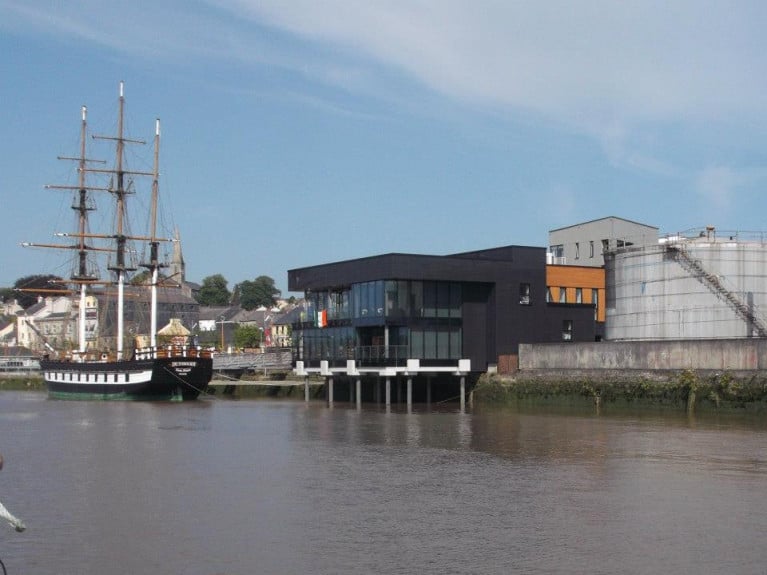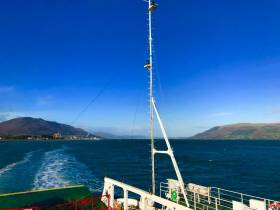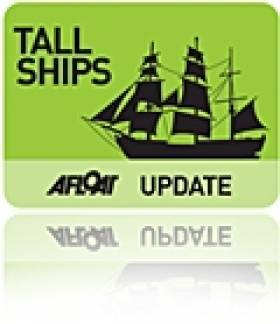Displaying items by tag: New Ross Boat Yard
A Co Wexford boatyard says that a €340,000 investment under the Brexit Blue Economy enterprise development scheme will allow it to work with heavier fishing and leisure vessels for dry dock and repair.
New Ross Boat Yard has taken delivery of a 60-ton hoist that will not only handle bigger vessels but is also more energy efficient, operating on reduced diesel.
The well-known marine facility extends to over four acres and has 230 metres of shoreline to the west of the River Barrow, as well as access to the rivers Nore and the Suir.
One of its key facilities is a 15-metre by 70-metre-long dry dock used for servicing large commercial fishing boats and ferries, as well as smaller leisure boats.
The boatyard has also used the funding to invest in a 10 KW wind turbine and solar panels which are reducing energy bills and the businesses carbon footprint.
The boatyard received total grant aid of €170,000 towards its €340,000 investment under the Brexit Blue Economy Enterprise Development Scheme.
The scheme is funded by the European Union under the Brexit Adjustment Reserve.
Boat Yard owner Michael Kehoe said the former 25-year-old boat hoist could only lift 50 tons, was not energy efficient, and needed more and more maintenance to keep it in working order.
“We had a number of boats that we were no longer in a position to take into the yard due to the capacity of this lift,”he explained.
“The new lift has made a huge difference. It means we can take on bigger boats, and see the weights displayed on each lifting point, something which is very important and allows us to distribute weight when lifting a vessel,” he said.
At any given time, there are over 100 boats in the yard representing a mix of fishing and leisure boats in for servicing and repair, and for winter storage.
Currently, the yard is servicing two ‘mini-cruise’ ships - the Barrow Princess and Cailín Déise owned by the Three Sisters Cruise Company. The company runs mini cruises along the rivers Suir and Barrow.
The boatyard also does important maintenance work on the Dunbrody famine replica, which is based on New Ross quay front.
New Ross Boat Yard has a history dating back 50 years. At its height in the 1970s, it employed around 400 people and supported vessels that sailed all over the globe.
Michael Kehoe and his brother Stephen bought the boat yard in 2008 and they invested in the refurbishment of the dry dock as well as building a storage facility, showroom, offices and storerooms.
It offers boat sales, services, and storage facilities all on-site, and has one of only three dry docks in Ireland measuring 70 meters in length.
Before the solar panels and wind turbine were introduced, the yard's electricity bills were €2,500 a month.
“By being able to offset the cost of our electricity bills and possibly selling electricity back to the grid, we are in a position to protect ourselves against future price rises,” Kehoe said.
Dunbrody's Dawn Departure for €700,000 Dry Dock Makeover
The tallship Dunbrody Famine Ship was brought by tug across the Barrow last Monday to New Ross Boat Yard to go into dry dock for three months, during which time she will have extensive works carried out.
Work began on removing the (20 year old replica) vessel and the gangways from 5 a.m.
A crane was used to lift the gangway onto a truck and to disengage the rollers from the piles, prior to a tug bringing her safely across the river on a high tide, where she slipped into dry dock at 8 a.m.
Preparatory work was carried out over the previous fortnight.
Dunbrody Experience Visitor Centre CEO Sean Connick thanked local boat owners and New Ross Boat Yard staff for their work, along with Tom Byrne and John Dimond.
Further reading from the New Ross Standard here.
Carlingford Ferry Makes En-Route Call to Arklow Port Prior to Dry-Docking
#FerryNews - Aisling Gabrielle, the ro-ro vessel that launched the first ever Carlingford Lough ferry service last year departed Arklow Port this morning for dry-docking purposes, writes Jehan Ashmore.
The 44-vehicle Aisling Gabrielle opened the new cross-border service linking Greenore Co. Louth and Greencastle, Co. Down last summer, saving considerably mileage and journey times. A relief ferry, Frazer Mariner since the weekend maintains the 20 minute crossings. The service also generated new tourism potential and economic benefits for communities on both shores of the lough.
As for Aisling Gabrielle, a departure took place from nearby Carlingford Pier yesterday and which led to an arrival in Arklow Port mid-afternoon. The en-route call was to load bunkers and a crew rest overnight, with the ferry moored alongside the North Quay.
The same process took place in Wicklow Port last year where Afloat reported of the repositioning voyage of the former Foyle Venture. The ferry had emerged fresh from drydocking in New Ross complete with name change and corporate livery in advance of the new service.
While Aisling Gabrielle is off service for scheduled annual drydocking maintenance, this again sees the return of the UK built ferry to the Wexford Boatyard on the banks of the River Barrow.
As the name suggests, Frazer Mariner is this also operated by the Frazer Ferries Group. The Limerick based company opened the new Scenic Carlingford Ferry service as well as to the re-opening last year of the Lough Foyle service.
Likewise the north-western service is branded similarly as Scenic Lough Ferry, though the Greencastle, Co. Donegal-Magilligan, Co. Derry service is seasonal-only, April to September.
Last year, Aisling Gabrielle also carried out relief crossings for the Group's Waterford estuary service which link's Passage East, Co. Waterford and Ballyhack, Co. Wexford.
The route operated by the 28-vehicle F.B.D. Dunbrody along with the Passage East Ferry Co where acquired by the Group in 2016. The operation continues to trade under the previous name.
It remains to be seen if Aisling Gabrielle during its south-east call will also lead the ferry to relieve on the Passage East service as was the case last year.
The Return of the 'Wexford' Tall-Ship
A grant of €1m from Fáilte Ireland was allocated towards the cost of the refit as part of the National Development Plan (NDP). Visitors can now take guided tours of the floating tourist attraction though access to the shoreside visitor centre remains closed due to an upgrade. Work on an extension of a new exhibition centre is expected to be completed in May or June.
Dunbrody is a full scale reconstruction of the 19th century replica famine-ship based on the vessel built in 1845 in Quebec, Canada for the Graves family of New Ross. Ireland's most inland port being made famous with the visit of President John F. Kennedy in 1963 to the same quayside where Dunbrody is berthed.
To date the Dunbrody's presence outside her homeport has been scarce. During the Waterford Tall Ships Festival in 2005 she took part in a memorable and historic 'Parade of Sail' where she formed as part of the trio of Irish tall ships that met together for the only time. The sailing spectacle of the international fleet was headed firstly by the Irish trio with Asgard II leading followed by Dunbrody and astern the Jeanie Johnston.
In the following year Dunbrody made her maiden and only international voyage to Milford Haven in south Wales. The Pembrokeshire estuary had hosted the new festival, Seafair Haven. On that occasion she had the honour of leading another parade of sail, under the command of Captain Tom McCarthy.
Dunbrody was last dry-docked in 2006 and also at the New Ross boatyard which lies on the Co. Kilkenny side of the riverbank. The 176 foot / 54 metre barque was built in 2001 and was last vessel completed at the boatyard. During her building the public could access the yard and the construction process could be viewed from above at a gallery set within the covered building hall.
The structure no longer exists but which was built originally for the Ross Company boatyard during the 1970's. The yard specialised in building barge pontoons for markets in the North Sea until the premises closed in the 1980's. In recent years and under new management the dry-dock (75m X 15m) has been upgraded with a new gate and pump.
Looking for further reading on Tall Ships in Ireland? Click the links below:
Click this link to read all our Tall Ships Stories on one handy page
Previewing Ireland's Tall Ships 2011 Season
Can Ireland Get a New Tall Ship?
- Asgard II
- Jeanie Johnston
- river barrow
- New Ross
- River Suir
- Milford Haven
- Ports and Shipping News
- barque
- Fáilte Ireland
- Dunbrody
- Parade of Sail
- Brigantine
- Waterford Tall Ships Festival
- Dunbrody Heritage Centre
- River Nore
- New Ross Boat Yard
- Sea Haven
- National Development Plan
- NDP
- President John F. Kennedy
- Capt. Tom McCarthy
- Ross Company
- Seafair Haven


























































